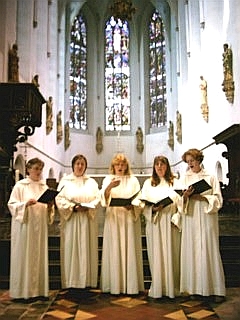
Home
Schola Catharina
Programme
A history of Gregorian Chant
Graduale Triplex
Gregorian Chant today
Contact us
Listen to the Chant
Photos
History of gregorian chant
Just as western litterature begins with the timeless masterpiece of Homer - the Illiad and the Odyssee - western musical history begins with the timeless 'masterpiece' of Gregorian chant; music which survived the centuries due to its undisputed musical and liturgical value.
"The Gregorian Chants are one of the great treasures of Western civilization. ........... and include some of the noblest artistic works ever created in pure melody." *)
Gregorian chant (Plain chant) is the oldest christian music. It dates from the first centuries of christianity, continuing the Jewish tradition both musicaly and textualy. The major part of the texts consists of psalms; and scolars agree that gregorian chant comes from the reciting of texts on one level (pitch), usual to the synagoge. With the years Plain chant developped a rich ornamentation.
The words 'Amen' and 'Halleluia' are relics of the Jewish origins of the liturgy.
Within a short time Greek became the liturgical language. This was the international language of the time and successively used by the christians Jews expelled from their synagoges since they got more and more followers out of the Jewish community. A Grecian relic in modern liturgy is 'Kyrie eleison' (Lord have mercy).
When Rome became the centre of christian faith, liturgical language changed into Latin. Here begins the development of Gregorian chant.
The chants were in the first place the preaching of the Word. So the text is of singular importance. In many places we find the content of the text, the meaning of the words, expressed in the melody of the chant, free of any rythm and based on prose. This, in contrast to the norm in classic antiquity, where chants were based on rythmical poetry.

Saint Gregory the Great, Pope (590-604), inspired by th Holy Spirit (the dove on his shoulder)
Around the year 600 AD the church possessed already a wealth of melodic chant (the so-called 'vieux fond'). Only in later centuries is the name of Pope Gregory the Great (590-604) associated with the chant. He founded a School of Choral Singing in Rome and his influence spread so much that this form of chant acquired his name. He is depicted in illustrations with a dove on his shoulder indicating the inspiration of the Holy Spirit.
During all the Middle-Ages everyone tried to preserve the 'true Gregorian chant' as sacred music. They did succeed wonderfully as one can see from the manuscpripts. First there was only an oral tradition. But from the 10the century on monasteries began to note the music above the texts, each on their own different way. But when different manuscripts are compared they scarcely differ one from another.
Gregorian chants are the basis of the later polyphony. The whole tradition of western classical music derives from Gregorian chant.
*) Grout, Donald J. and Pallisca, Claude V., A History of Western Music; third edition 1980 Yale isbn 0-460-04546-6:
" The Gregorian Chants are one of the great treasures of Western civilization. Like romanesque architecture, they stand as a monument to medieval man's religious faith; they where the source and inspiration of a large proportion of all Western music up to the sixteenth century. They constitute one of the most ancient bodies of song still in use anywhere, and include some of the noblest artistic works ever created in pure melody." (p. 22/23)
Heleen Keller
Home